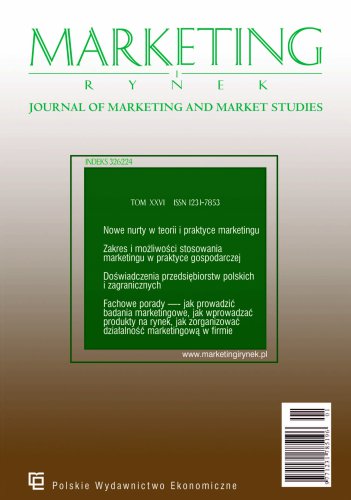Zielony kapitał relacyjny jako instrument budowania konkurencyjności przedsiębiorstw
Zielony kapitał relacyjny to unikatowy zasób wspomagający proekologiczne zarządzanie przedsiębiorstwem. Celem artykułu jest ocena skali wdrożenia działań prowadzących do budowania tego kapitału oraz identyfikacja postaw polskich menedżerów w zakresie oddziaływania tych praktyk na konkurencyjność organizacji. Badaniami objęto 150 przedsiębiorstw zlokalizowanych na terenie Polski. W toku badań stwierdzono lukę w zakresie implementacji działań prowadzących do budowania zielonego kapitału relacyjnego. Ustalono, że kapitał ten jako instrument budowania konkurencyjności jest wykorzystywany zaledwie w połowie badanych podmiotów. Zdiagnozowana luka może stanowić impuls stymulujący zainteresowanie tą problematyką w polskich organizacjach.
Bibliografia
Bibliografia/References
Barney, J. (1991). Firm Resources and Sustained Competitive Advantage. Journal of Management, 17(1), 99–120. https://doi.org/10.1177/014920639101700108
Bathmanathan, V. i Hironaka, Ch. (2016). Sustainability and business: what is green corporate image? IOP Conference Series Earth and Environmental Science, 320, 012049. https://doi.org/10.1088/1755-1315/32/1/012049
Bati, U. (2016). Green Marketing Activities to Support Corporate Reputation on a Sample from Turkey. International Journal of Marketing Studies, 8, 189–201. https://doi. org/10.5539/ijms.v8n3p189
Behrend, T. S., Baker, B. A. i Thompson, L. F. (2009). Effects of pro-environmental recruiting messages: The role of organizational reputation. Journal of Business and Psychology, 24(3), 341–350.
Bombiak, E. (2012). Kapitał relacyjny w nowoczesnych organizacjach — istota i pomiar. W: M. Cisek i M. Wakuła (red.), Odpowiedzialne zarządzanie: wybrane aspekty. Warszawa: Studio Emka.
Bombiak, E. (2013). Kapitał intelektualny przedsiębiorstwa — kluczowy majątek wspołczesnych organizacji. Zeszyty Naukowe Uniwersytetu Przyrodniczo-Humanistycznego w Siedlcach, Seria: Administracja i Zarządzanie, 96, 74–86.
Chaharbaghi, K. i Cripps, S. (2006). Intellectual capital: direction, not blind faith. Journal of Intellectual Capital, 7(1), 29–32. https://doi.org/10.1108/14691930610639750
Chen, P. i Hung, S. (2014). Collaborative green innovation in emerging countries: A social capital perspective. International Journal of Operations & Production Management, 34(3), 347–363. https://doi.org/10.1108/IJOPM-06-2012-0222
Chen, Y. S. (2008). The Positive Effect of Green Intellectual Capital on Competitive Advantages of Firms. Journal of Business Ethics, 77, 271–286. https://doi.org/10.1007/s10551-006-9349-1
Clarke, M., Seng, D. i Whiting, R. (2011). Intellectual Capital and Firm Performance in Australia. Journal of Intellectual Capital, 12, 505–530. https://doi.org/10.1108/14691931111181706
Dilling, P. F. A. (2010). Sustainability Reporting in a Global Context: What are the Characteristic of Corporation that Provide High Quality Sustainability Reports — An Empirical Analysis. International Business & Economics Research Journal, 9, 19–30. https://doi.org/10.19030/iber.v9i1.505
Edvinsson, L. i Malone, M. S. (2001). Kapitał intelektualny. Warszawa: PWN.
Hair, J., Anderson, R., Black, B. i Babin, B. (2016). Multivariate Data Analysis, 7th ed., New York: Pearson, Upper Saddle River.
Kasiewicz, S., Rogowski, W. i Kicinska, M. (2006). Kapitał intelektualny. Krakow: Oficyna Ekonomiczna.
Kay, J. (1996). Podstawy sukcesu firmy. Warszawa: PWE.
Komnenic, B. i Pokrajeić, D. (2012). Intellectual capital and corporate performance of MNCs in Serbia. Journal of Intellectual Capital, 13(1), 106–119. https://doi.org/10.1108/14691931211196231
Kurzak, A. (2013). Zielony marketing jako element współczesnego marketingu. W: J. M. Osiński i M. Pachocka (red.), Zmieniający się świat. Pespektywa demograficzna, społeczna i gospodarcza. Warszawa: SGH.
Lev, B. (2001). Intangibles: Management, Measurement, and Reporting. Washington: The Brookings Institution.
Li, J. X., Sun, X. i Li, G. (2018). Relationships among green brand, brand equity and firm performance: Empirical evidence from China. Transformations in Business and Economics, 17(3), 221–236.
Mendyk, I. (2007). Kapitał relacyjny w identyfikowaniu luki kompetencyjnej przedsiębiorstwa. W: A. Sitko-Lutek (red.), Polskie firmy wobec globalizacji. Luka kompetencyjna. Warszawa: PWN.
Nair, S. R. I Menon, C. G. (2008). An environment marketing system — a proposed model based on Indian experience. Business Strategy and the Environment, 17, 467–479. https: //doi. org/10.1002/bse. 586
Nivlouei, F. B. i Khass, E. D. (2014). The Role of Green Intellectual Capital Management in Acquiring Green Competitive Advantage for Companies. International Journal of Management Research and Development, 4(2), 41–58.
Papadasa, K-K., Avlonitisb, G. J., Carriganc, M. i Pihad, L. (2019). The interplay of strategic and internal green marketing orientation on competitive advantage. Journal of Business Research, 104, 632–643. https://doi.org/10.1016/j.jbusres.2018.07.009
Sidik, M. H. J., Yadiati, W., Lee, H. i Khalid, N. (2019). The Dynamic Association of Energy, Environmental Management Accounting and Green Intellectual Capital with Corporate Environmental Performance and Competitive Advantages. International Journal of Energy Economics and Policy, 9(5), 379–386. https://doi.org/10.32479/ijeep.8283
Woo, C., Kim, M. G., Chung, Y. i Rho, J. J. (2016). „Suppliers” communication capability and 32 external green integration for green and financial performance in Korean construction industry. Journal of Cleaner Production, 112, 483–493. https://doi.org/10.1016/j.jclepro.2015.05.119
Yadiati, W., Nissa, N., Paulus, S., Suharman, H., Meiryani, M. (2019). The Role of Green Intellectual Capital and Organizational Reputation in Influencing Environmental Performance. International Journal of Energy Economics and Policy, 9(3), 261–268. https://doi.org/10.32479/ijeep.7752
Yahya, N. A., Arshad, R. i Kamaluddin, A. (2014). Measuring green intellectual capital in Malaysian environmentally sensitive companies. International Journal of Business and Management Study, 1(2), 92– 96.
Yahya, N. A., Arshad, R., Kamaluddin, A. i Rahman, R. A. (2019). Green Intellectual Capital and Firm Competitive Advantage: Evidence from Malaysian Manufacturing Firms. The Journal of Social Sciences Research, 5(2), 463–471. https://doi.org/10.32861/jssr.52.463.471
Yong, J. Y., Yusliza, M-Y., Ramayah, Y. i Fawehinmi, O. (2019). Nexus between green intellectual capital and green human resource management. Journal of Cleaner Production, 215, 364–374. https://doi.org/10.1016/j.jclepro.2018.12.306
Youndt, M. A., Subramaniam, M. i Snell, S. (2004). Intellectual Capital profiles. An examination of investments and returns. Journal of Management Studies, 16, 337–61. https://doi.org/10.1111/j.1467-6486.2004.00435.x
Yusliza, M-Y., Yong, J. Y., Tanveer, M. I., Ramayah, T., Faezah, J. N., Muhammad, Z. (2020). A structural model of the impact of green intellectual capital on sustainable performance. Journal of Cleaner Production, 249, 119334. https://doi.org/10.1016/j.jclepro.2019.119334

